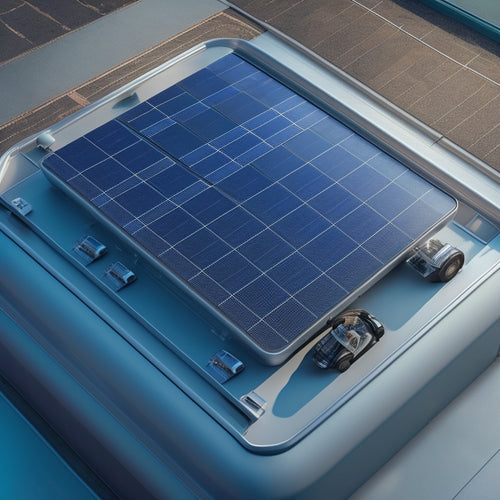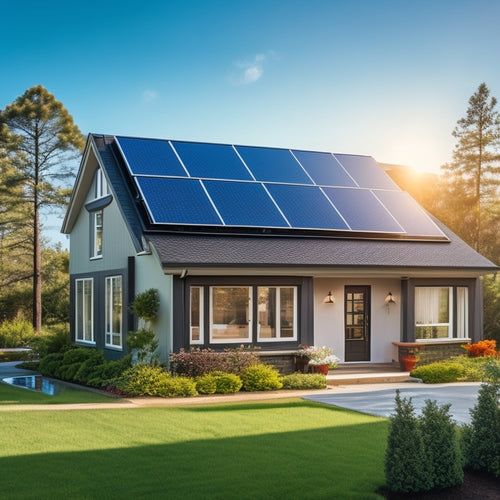
Optimize Your Residential Panel System Performance
Share
You can optimize your residential panel system's performance by implementing a combination of regular maintenance, inspections, and optimizations. Start by scheduling regular cleaning sessions, inspecting for loose connections daily, and monitoring energy output regularly. Trim nearby trees and vegetation, and check for panel damage often. Inspect inverters for efficiency, and perform load bank testing annually. Don't forget to inspect your roof condition periodically and check for animal infestation. By following these best practices, you'll be well on your way to maximizing your system's energy output and lifespan. Now, explore additional strategies to take your system's performance to the next level.
Key Takeaways
• Regularly clean panels to prevent dust buildup and ensure maximum energy output.
• Optimize panel placement for seasonal changes to maximize sunlight exposure.
• Inspect and maintain inverters to ensure efficient energy conversion.
• Monitor energy production levels and analyze data to identify trends and issues.
• Perform regular inspections to detect and address potential issues before they affect performance.
Schedule Regular Cleaning Sessions
Regular cleaning sessions are crucial to maintaining your residential panel system's peak performance, as debris and dirt accumulation can greatly reduce energy output. You wouldn't want all that hard-earned sunlight going to waste, right?
To avoid this, establish a cleaning frequency that suits your system's needs. A general rule of thumb is to clean your panels every 2-4 weeks, depending on the amount of debris in your area. However, if you live in an area prone to heavy pollution, dust, or foliage, you may need to clean them more frequently.
Consider creating seasonal schedules to tackle specific cleaning tasks. For instance, during spring and fall, focus on removing pollen and leaves, while winter months may require snow removal.
Inspect for Loose Connections Daily
As you inspect your residential panel system daily, you'll want to perform a visual inspection to identify any loose connections. Check for signs of corrosion, such as rust or oxidation, which can weaken connections over time.
Verify that all fastenings are secure, ensuring your system operates safely and efficiently.
Daily Visual Inspections
You should conduct daily visual inspections to identify and tighten any loose connections in the residential panel system, guaranteeing reliable operation and preventing potential faults. As the system's guardian, it's your responsibility to keep it running smoothly.
To make the most of your daily inspections, invest in inspector training to equip yourself with the necessary skills to identify potential issues. A well-trained inspector can spot problems before they become major headaches.
Create a visual checklist to guide your daily inspections. This will help you stay focused and make certain that you don't miss a thing. Divide your checklist into sections, covering components like connections, wires, and panels.
Be meticulous in your inspections, and don't hesitate to tighten any loose connections you find. Remember, a loose connection today can develop into a major fault tomorrow.
Check for Corrosion Signs
During daily inspections, scrutinize connections for signs of corrosion, such as rust, verdigris, or white residue, which can indicate loose connections or water ingress. You don't want your system to be compromised by something as preventable as corrosion.
Pay particular attention to areas prone to moisture accumulation, like coastal exposures, where saltwater and humidity can accelerate corrosion. When inspecting, keep an eye out for loose connections, as they can lead to arcing, overheating, and even system failure.
Proper material selection can also help mitigate corrosion risks. Opt for corrosion-resistant materials, like anodized aluminum or stainless steel, which can withstand harsh environmental conditions. Additionally, make sure that all connections are secure and properly sealed to prevent water ingress.
Remember, a little corrosion can lead to big problems down the line. By staying vigilant and addressing corrosion signs early, you'll be guaranteeing your residential panel system performs at its best.
Verify Secure Fastenings
Daily inspections should include a thorough examination of all fastenings to make sure they're securely tightened, as loose connections can compromise your residential panel system's performance. You don't want to risk compromising the structural integrity of your system, right?
Here are some key things to check:
-
Inspect all bolts, screws, and clamps: Look for signs of wear, rust, or corrosion that could weaken their grip.
-
Check for loose or missing fasteners: Make sure every bolt, screw, and clamp is securely in place and tightened to the recommended torque specification.
-
Verify proper fastening techniques: Ensure that all fasteners are installed using approved fastening techniques to prevent damage or stripping.
- Don't neglect the small stuff: Even the smallest loose connection can have a significant impact on your system's performance over time.
Monitor Energy Output Regularly
Regular monitoring of your residential panel system's energy output helps identify potential issues early, ensuring peak performance and maximizing your return on investment. By keeping a close eye on your system's energy production, you can detect potential problems before they escalate into major issues. This proactive approach will help you maintain top performance and avoid costly repairs.
To make the most of your monitoring efforts, leverage data analytics and energy forecasting tools. These advanced technologies provide valuable insights into your system's energy output, helping you identify trends, patterns, and anomalies.
Here's a snapshot of what you can expect from regular monitoring:
| Metric | Target Range | Alert Threshold |
| Energy Output (kWh) | 90-110% of expected output | < 80% of expected output |
| System Efficiency (%) | 95-100% | < 90% |
| Temperature (°C) | 25-40°C | > 45°C or < 20°C |
| Inverter Performance (%) | 95-100% | < 90% |
| Grid Connection Status | Online | Offline |
Trim Trees and Vegetation Nearby
As you maintain your residential panel system, don't forget to trim trees and vegetation nearby.
Overgrown branches and leaves can cast shadows on your panels, reducing their energy output, so it's crucial to keep them under control.
Reduce Shading Impact
To maximize the energy output of your residential panel system, trim trees and vegetation nearby to reduce shading impact, as even partial shading can greatly diminish performance. Shady spots can be a real energy suck (pun intended). But don't worry, with a little pruning, you can get your system back to its sun-kissed self.
Here are some key takeaways to keep in mind:
-
Conduct a Shading Analysis: Identify areas where trees or structures cast shade on your panels, and prioritize trimming those spots first.
-
Create an Obstruction Mapping: Map out the areas around your panels to identify potential obstructions and plan your trimming strategy accordingly.
-
Trim regularly: Set a schedule to trim trees and vegetation regularly to maintain peak energy output.
- Consider seasonal changes: Be mindful of how seasonal changes might affect shading patterns and adjust your trimming schedule accordingly.
Clear Debris Regularly
Debris like fallen leaves, twigs, and bird droppings can significantly reduce your residential panel system's energy output, so it is essential to clear your panels regularly. You don't want your system's performance to go from 100 to 0 because of some pesky plant material, do you? Clearing debris is especially important during seasonal changes when trees and vegetation nearby shed more frequently.
To keep your system running smoothly, create a seasonal maintenance schedule that includes debris removal. Here's a rough guide to get you started:
| Season | Debris Removal Tools |
|---|---|
| Spring | Soft-bristled brush, leaf blower |
| Summer | Water hose, soft-bristled brush |
| Autumn | Leaf blower, rake |
| Winter | Snow brush, soft-bristled brush |
| Year-round | Soft-bristled brush, microfiber cloth |
Invest in a good debris removal tool set, and you'll be all set to tackle any mess Mother Nature throws your way. Remember, a clean panel system is a happy panel system!
Check for Panel Damage Often
Regularly inspecting your residential panel system for signs of damage is crucial to guaranteeing peak performance and preventing potential safety hazards. You don't want a damaged panel to compromise your entire system, reducing energy output and increasing the risk of electrical malfunctions.
Here are some key things to check for during your inspections:
-
Cracks or breaks in the panel glass: Even small cracks can jeopardize the panel's weather resistance, so it's vital to address them promptly.
-
Loose or corroded connections: Make sure all connections are secure and free from corrosion to ensure efficient energy transmission.
-
Panel misalignment or tilting: Ensure your panels are properly aligned and tilted to maximize energy output.
- Signs of pest or rodent infestation: Keep an eye out for signs of unwanted critters taking up residence in your panel system.
Update System Software Frequently
Your residential panel system's software is the cornerstone of its operation, and updating it frequently guarantees that your system runs smoothly, efficiently, and safely. Think of software updates like getting a flu shot – it protects your system from cybersecurity threats and keeps it running at peak performance. Outdated software can leave your system vulnerable to hackers, which can lead to data breaches and even system failure.
Here's why frequent software updates are essential:
| Reason | Benefit |
|---|---|
| Improved cybersecurity | Protects your system from data breaches and cyber attacks |
| Enhanced data analytics | Provides more accurate insights into your energy usage and production |
| Increased efficiency | Optimizes energy production and reduces waste |
| Better system integration | Ensures seamless communication between components |
| Bug fixes and patches | Resolves issues and prevents system downtime |
Inspect Inverters for Efficiency
When inspecting your residential panel system's inverters for efficiency, you'll want to focus on three key areas.
First, you'll need to evaluate your inverter monitoring systems to make sure they're providing accurate data.
Inverter Monitoring Systems
You can greatly enhance the overall efficiency of your residential panel system by inspecting and monitoring the inverters that convert DC power from the panels to AC power for your home. Inverter monitoring systems are designed to optimize performance, identify potential issues, and reduce downtime.
With real-time tracking, you can stay on top of your system's performance and make data-driven decisions to maximize energy production.
Here are some key benefits of inverter monitoring systems:
-
Real-time monitoring: Get instant updates on your system's performance, allowing you to identify and address issues promptly.
-
Data analytics: Analyze your energy production data to optimize your system's performance and reduce energy waste.
-
Alert systems: Receive notifications when your system is underperforming or experiencing issues, ensuring you can take prompt action.
- Remote monitoring: Monitor your system from anywhere, at any time, giving you greater control and flexibility.
Heat Management Strategies
During peak operating hours, inefficient heat management can lead to reduced inverter performance, highlighting the importance of inspecting inverters for best heat dissipation.
You can't afford to let heat issues bring your system down, especially during peak sun hours when every watt counts.
To stay on top of heat management, it's vital to inspect your inverters regularly. Use thermal imaging to identify hotspots and heat mapping to visualize temperature distributions. This proactive approach helps you pinpoint areas where heat is building up, allowing you to take corrective action before it's too late.
By keeping your inverters running cool, you'll guarantee maximum efficiency and prolong their lifespan. Remember, a well-managed heat strategy is key to optimizing your residential panel system's performance.
Don't let heat get in the way of harnessing the sun's full potential – stay vigilant and keep your system running smoothly!
Energy Loss Detection
By maintaining a cool operating temperature, you've taken the first step in optimizing inverter performance, but it's equally important to detect energy losses to make sure your residential panel system is running at its best.
Now it's time to inspect your inverters for efficiency. Think of it as a health check for your system - you want to identify any energy-sucking vampires that might be lurking in the shadows.
Here are some key areas to focus on:
-
Energy mapping: Create a visual representation of your system's energy flow to identify areas of inefficiency.
-
Thermal imaging: Use specialized cameras to detect temperature anomalies that could indicate energy losses.
-
Inverter monitoring: Keep a close eye on your inverter's performance metrics to catch any dips in efficiency.
- On-site inspections: Regularly inspect your system's physical components to make certain everything is in working order.
Check for Animal Infestation
Regularly inspecting your residential panel system is crucial to detecting signs of animal infestation, which can cause damage to the system's electrical components. You might think it's unlikely, but wildlife loves to make themselves at home in your electrical system.
It's not uncommon to find critters like raccoons, squirrels, or rodents making themselves cozy in your panel system, turning it into their own personal wildlife habitat. These uninvited guests can chew on wires, causing electrical shorts and even fires.
To avoid this, it's vital to check for signs of animal infestation regularly. Look for droppings, gnaw marks, or nesting materials like twigs and leaves. If you suspect an infestation, it's time to call in the pest control pros. They'll humanely remove the critters and seal any entry points to prevent future unwanted visitors.
You can also take preventative measures like sealing any holes or gaps in your panel system and using animal-deterrent materials like rodent-resistant wiring. By staying on top of animal infestation, you'll guarantee your residential panel system runs smoothly and safely.
Perform Load Bank Testing Annually
You should conduct load bank testing annually to confirm that your residential panel system can handle maximum electrical loads without overheating or failing. This test simulates real-world conditions, pushing your system to its limits to verify it can handle the demand. Think of it as a stress test for your panel system - it's like running a marathon, but for your electrical system!
Here are some key benefits of load bank testing:
-
Confirms system reliability: Verify that your system can handle peak loads without failing or overheating.
-
Optimizes performance: Identify areas for improvement to maximize your system's efficiency.
-
Meets testing standards: Complies with industry standards, such as UL and IEEE, for load bank testing and calibration.
- Extends system lifespan: Prevents premature wear and tear on your system, reducing the need for costly repairs or replacements.
Inspect Roof Condition Periodically
Regular load bank testing should be complemented by periodic roof inspections to verify that your residential panel system's performance isn't compromised by underlying roof issues. You see, a faulty roof can lead to a faulty system - it's like building a dream house on shaky ground (literally!).
As you inspect your roof, consider its age and material. An older roof may require more frequent inspections, while certain materials (like asphalt shingles) might be more prone to damage.
When inspecting, look for signs of wear and tear, such as curled or buckled shingles, missing granules, or rust on metal roofs. Check for damaged or loose flashing, which can cause water seepage and compromise your system's performance.
Don't forget to inspect the roof's structural integrity, ensuring it can support the weight of your panels. Finally, keep an eye out for debris, like leaves or branches, that might obstruct your panels or compromise airflow.
Frequently Asked Questions
What Is the Ideal Cleaning Solution for My Solar Panels?
When cleaning your solar panels, you'll want to use deionized water and micro cleaning technology to avoid scratching the surface; it's like washing your car - gentle and precise, no harsh chemicals or abrasive scrubbers, please!
Can I Clean My Solar Panels During Peak Sun Hours?
You're wondering if you can clean your solar panels during peak sun hours? Not recommended! Peak temperature and morning dew can make cleaning tricky; instead, clean during cooler hours to avoid streaks and guarantee a sparkling clean panel.
How Often Should I Inspect My System's Wiring and Connections?
You should inspect your system's wiring and connections every 6-12 months, checking for signs of wear, corrosion, or overheating. Perform voltage checks to verify they're within spec, and be prepared to mitigate electrical surges that can wreak havoc on your system.
Will Trimming Trees Nearby Affect the Surrounding Ecosystem?
When you trim trees, you're not just pruning branches, you're impacting the local wildlife habitat and soil quality. Be mindful of the ecosystem's delicate balance, or you might just find yourself at odds with Mother Nature!
Are There Any Local Regulations for Solar Panel Maintenance?
Before installing solar panels, you'll need to check if your local government requires special permits or adheres to specific municipal codes, ensuring you comply with regulations and avoid potential fines or penalties.
Related Posts
-

Top Solar Panels for Car Battery Maintenance
When selecting top solar panels for car battery maintenance, consider high-efficiency models with high wattage output...
-

Top Online Stores for Solar Car Accessories
When searching online for solar car accessories, you'll find top retailers like Amazon, REI Co-op, and Best Buy offer...
-

Solar Power Units Perfect for Homes
You're considering installing a solar power unit in your home, a decision that can notably reduce your reliance on tr...


